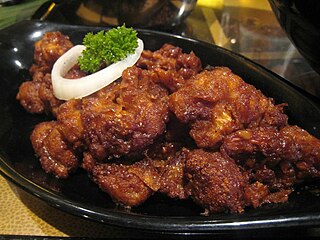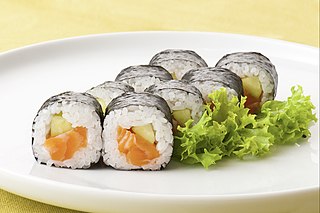
Fusion cuisine is a cuisine that combines elements of different culinary traditions that originate from different countries, regions, or cultures. Cuisines of this type are not categorized according to any one particular cuisine style and have played a part in many contemporary restaurant cuisines since the 1970s.

Japanese cuisine encompasses the regional and traditional foods of Japan, which have developed through centuries of political, economic, and social changes. The traditional cuisine of Japan is based on rice with miso soup and other dishes with an emphasis on seasonal ingredients. Side dishes often consist of fish, pickled vegetables, and vegetables cooked in broth. Common seafood is often grilled, but it is also sometimes served raw as sashimi or as sushi. Seafood and vegetables are also deep-fried in a light batter, as tempura. Apart from rice, a staple includes noodles, such as soba and udon. Japan also has many simmered dishes, such as fish products in broth called oden, or beef in sukiyaki and nikujaga.

Sushi is a Japanese dish of prepared vinegared rice, usually with some sugar and salt, plus a variety of ingredients, such as vegetables, and any meat, but most commonly seafood. Styles of sushi and its presentation vary widely, but the one key ingredient is "sushi rice", also referred to as shari (しゃり), or sumeshi (酢飯).

Sashimi is a Japanese delicacy consisting of fresh raw fish or meat sliced into thin pieces and often eaten with soy sauce.

Gimbap, also romanized as kimbap, is a Korean dish made from cooked rice, vegetables, fish, and meat rolled in gim—dried sheets of seaweed—and served in bite-sized slices. The origins of gimbap are debated. Some sources suggest it originates from Japanese norimaki, introduced during Japanese colonial rule, while others argue it is a modernized version of bossam from the Joseon era. The dish is often part of a packed meal, or dosirak, to be eaten at picnics and outdoor events, and can serve as a light lunch along with danmuji and kimchi. It is a popular takeaway food in South Korea and abroad and is known as a convenient food because of its portability.

The history of sushi began with paddy fields, where fish was fermented with vinegar, salt and rice, after which the rice was discarded. The earliest form of the dish, today referred to as narezushi, was created in Japan around the Yayoi period. In the Muromachi period (1336–1573), people began to eat the rice as well as the fish. During the Edo period (1603–1867), vinegar rather than fermented rice began to be used. The dish has become a form of food strongly associated with Japanese culture.

Kappamaki, cucumber sushi roll, is a norimaki with cucumber core. It is a typical thin sushi roll along with dried gourd rolls and iron fire rolls.

California roll or California maki is an uramaki containing imitation crab, avocado, and cucumber. Sometimes crab salad is substituted for the crab stick, and often the outer layer of rice is sprinkled with toasted sesame seeds or roe.

Poke is a dish of diced raw fish tossed in sauce and served either as an appetizer or a main course.

A spider roll is a type of makizushi sushi that includes breaded or battered soft-shell crab and other ingredients such as cucumber, avocado, daikon sprouts or lettuce, and spicy mayonnaise, rolled inside nori and sushi rice.

The B.C. roll is a Maki-zushi (roll), a kind of sushi containing barbecued salmon and cucumber. It is prepared as an uramaki roll, a style of sushi in which the rice is on the outside. Often the roll contains barbecued salmon skin coated in a sweet sauce. There are many variations of this roll including barbecued salmon skin with mayo.

Japanese cuisine has a vast array of regional specialities known as kyōdo ryōri (郷土料理) in Japanese, many of them originating from dishes prepared using local ingredients and traditional recipes.

A Seattle roll is a makizushi roll similar to the Philadelphia roll. The fundamental recipe consists of raw salmon and cream cheese, usually along with cucumber and/or avocado, and sometimes masago or tobiko. Variations include ingredients such as smoked or seared salmon. Noted by Seattle food critics, it can be found at numerous restaurants in Seattle. Like many Western-inspired sushi rolls, the ingredients and name are based on an American market.

Pacific Northwest cuisine is a North American cuisine that is found in the Pacific Northwest, i.e. the states of Oregon, Washington, Idaho and Alaska, as well as the province of British Columbia and the southern portion of the territory of Yukon, reflecting the ethnic makeup of the region, with noticeable influence from Asian and Native American traditions. With significant migration from other regions of the US, influences from Southern cuisine brought by African Americans as well as Mexican-American cuisine as Latinos migrate north from California, can be seen as well.

Norimaki (海苔巻) are various Japanese dishes wrapped with nori seaweed, most commonly a kind of sushi, makizushi (巻き寿司).

Rainbow roll is a type of uramaki sushi roll filled with cucumber, avocado and crab stick. It is prepared with multiple types of fish, most commonly tuna, salmon, white fish, yellowtail, snapper, and eel. Rainbow roll is quite similar to the California roll, with the addition of tuna, salmon and avocado. Other variants include slices of mango next to avocado, or uses of imitation crab meat, fried shrimp tempura, and other seafood.

Okazuya or okazu-ya are a Japanese-style delicatessen common in Hawaii. Unlike western delicatessens found in North America or Europe, an okazuya is an establishment that sells readymade Japanese-styled food. "Okazu" refers to a side dish to accompany rice, while "ya" refers to a retail establishment.

















